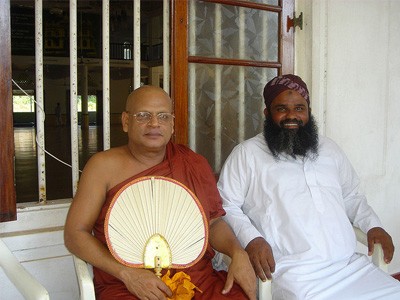Islamic-Buddhist dialogue
Islamic-Buddhist dialogue

Dr. Alex Berzin tells of his groundbreaking work in visiting Muslim countries and speaking with scholars and practitioners of Islam. These are probably some of the first dialogues to take place between people of those two religions in modern times, and are especially noteworthy because they occurred in Islamic countries, not in the West or in Asia.
Buddhists and Muslims have lived in close proximity for many centuries in India, Central Asia, and the Malaya Peninsula, extending as far as Indonesia. As with any two religions sharing a geographic area, at times their relationship has been stormy, at times peaceful. A portion of the Tibetan population is Muslim, and they lived together peacefully for centuries with the Tibetan Buddhists in Tibet prior to 1959. Now that His Holiness the Dalai Lama and the Tibetan government are in exile in India, His Holiness is seeking dialogue and contact with Muslims of many countries in an effort to promote mutual understanding and growth. While Buddhist dialogue with some other religions has been going on for some time, to my knowledge the dialogue with Muslims is at its initial stages. Therefore, at this time it is most important to establish common links, both philosophically, and in terms of examining social problems. Once this groundwork is laid, deeper spiritual exchange can take place.
Common links with social issues
As a student of His Holiness, my involvement in Islamic-Buddhist dialogue has developed gradually over many years. In my travels around the world lecturing on Buddhism, I have visited a number of Muslim countries. Initially, I did not directly engage Muslim audiences. Later, I entered into specifically Islamic-Buddhist dialogues when I became more aware of the potential for Islamic-Buddhist cooperation in dealing with some of the more pressing social issues that Muslim and Buddhist communities share. For example, the president of the Indian Ocean republic of Mauritius and I discussed the problem of drug abuse among unemployed, disheartened youth in Tibet and how his religious community was dealing with a similar issue in Mauritius. We shared common concerns about the problem and agreed on the importance of religion for instilling a sense of self-worth, community support, and ethics for uplifting those who have been affected. In Zanzibar, which is 95% Muslim, I met with local leaders and learned of their modest success in using Islam to help those who wish to break their heroin habit. When former addicts are kept busy with ritual washing and prayers five times a day, they do not have much idle time to fill with drugs. This example gives much food for thought in terms of the possible benefits of such physical activities as prostration for ethnic Buddhist addicts.
In Egypt, I visited Cairo University twice, where I met with professors and students of various faculties. One year I lectured on “The Impact of Buddhist Thought on Asian Political and Economic Development” at Cairo University. They were particularly interested to know how Buddhist principles contributed to the economic success of the “Asian tiger” nations so that they can use Islam to support a similar phenomenon of Egypt’s becoming an “African and Middle Eastern tiger.” They also sought to understand Asia and its religions in order to form better political and economic links with the region. They do not wish to be isolated under the misconception that all Muslims are fundamentalists or fanatic terrorists and were very interested in dialogue. They asked me to write a paper on the basic Buddhist teachings in a manner readily understandable to Muslims that was published in English and Arabic as one of their Asian Monograph Series which is distributed throughout the Arabic speaking world. To further Buddhist-Muslim understanding, we decided together that I should prepare a series of monographs on the history of the interaction between the Muslims and Buddhists in Central Asia and the Indian subcontinent. Since then, I have met with many distinguished Egyptian, Jordanian, Iraqi, Turkish, and Uzbek scholars of Islam who have been enthusiastic about this project and generous in offering their help and sharing their insights.
In this series I hope to dispel some misunderstandings about Buddhist-Muslim history. Just as modern journalists and political analysts are quick to suspect a Muslim fundamentalist hand behind terrorist acts in the world, historians of Central Asia and the Indian subcontinent have often had similar presuppositions. Throughout history, Buddhist monasteries and temples in these regions have been destroyed or naturally fallen into disrepair and abandoned for various reasons. Sometimes, economic conditions or natural disasters caused their closure, and other times they were sacked for their wealth or destroyed in wars for territorial gain or control of the lucrative trade along the Silk route. Yet popular histories attribute the decline of Buddhism and its monasteries in the area primarily to Islamic holy wars or jihads. In the future, it is important, especially in history textbooks for schools in Buddhist and Muslim countries, to present an unbiased, more objective account.
In Mafraq, Jordan, I visited and lectured on Buddhism and Tibet and their relationship with Islam at the Al al-Bayt University. This international university was founded to broaden mutual understanding among all seven sects of Islam, and between Islam and other world religions. The president of the university had been to Japan as the keynote speaker and co-organizer of a conference on Buddhist-Islamic understanding. He expressed interest in hosting such a conference in Jordan in the future. In addition, he is building a Buddhist section in the university library, which is generating more and more interest in the subject, and asked me to prepare a book list. The president offered to admit two Tibetan students to the university each year for training in Arabic and Islam. He preferred Buddhist monks who could do M.A. research on a comparison of Buddhism and Islam, but would also admit Tibetan Muslims who would wish to learn more about their religion to the B.A. program. His Holiness was extremely pleased by this offer and has asked his office to arrange to find appropriate candidates.
Common links in philosophy
In Turkey, I met with a group of professors of Islamic law at the Ilahiyat Islamic Theological Faculty of Marmara University in Istanbul to discuss the views of Islamic law towards Buddhism as a way to support Buddhist-Islamic religious harmony. In the Tibetan context, this is especially important due to the large influx of Hui (Chinese Muslim) settlers in Tibet in recent years. Since the seventeenth century, a community of Muslims has lived in Tibet. They were well-integrated into the predominantly Buddhist community and traditionally enjoyed special legal privileges granted by the Fifth Dalai Lama. However, the current strained situation in Tibet with the large population transfer from areas of Han China has produced understandable tensions.
The professors felt that, according to Islamic doctrine, there is no problem in establishing peaceful relations with Buddhists. They cited three reasons for this. First, certain modern Islamic scholars have asserted that the Prophet Dh’ul Kifl—the “man from Kifl”—mentioned twice in the Qur’an, refers to the Buddha, with Kifl being the Arabic rendering of the name of Buddha’s native kingdom, Kapilavastu. The Qur’an stated that the followers of Dh’ul Kifl are righteous people. Secondly, al-Biruni and Sehristan, two eleventh century Islamic scholars who visited India and wrote about its religions, called Buddha a “Prophet.” Thirdly, Kashmiri Muslims who settled in Tibet from the seventeenth century married Tibetan Buddhist women within the context of Islamic law.
I returned to the Ilahiyet Islamic Faculty of Marmara University, in Istanbul, a year after the initial meeting. The interview I had given during my previous visit to this university had been published in a popular magazine of the local Islamic fundamentalists, read in Turkey and throughout the Central Asian Islamic republics. The teachers were extremely enthusiastic in establishing an Islamic-Buddhist dialogue, and we discussed such issues as creation, revelation and the source of ethics. Islam asserts God not as a person but as an abstract creating principle, and some schools of Islamic theology assert that creation has no beginning. Speaking of the clear light mind as the beginningless creator of appearances, and of Buddha as a revealer of higher truths, we had a good basis for lively and friendly dialogue. I was touched by their interest in dialogue with Buddhists. In addition, the Municipal Government of Istanbul will sponsor an international, interfaith dialogue conference in 1997 and has requested His Holiness the Dalai Lama to send a representative.
Historically, Islamic law has accepted Buddhism as a “religion of the Book.” Because “Dharma” was translated as “law,” and “law” referred to “book,” Buddhists as “people of the Dharma” were understood to be “people of the Book” throughout medieval Central Asia. Islam tolerates all “people of the Book,” which is defined as people who accept a creator God. This leads to some interesting discussions on the meaning of “creator God.”
For example, the primarily Muslim state of Indonesia officially permits five religions—Islam, Catholicism, Protestantism, Hinduism and Buddhism—on the grounds that they all accept a creator God. In this regard, Indonesian Buddhists posit Adibuddha, the primordial Buddha of the Kalachakra Tantra, as the “creator.” I had several interesting discussions with Buddhist monks in Indonesia about the issue of God in Buddhism. Since Adibuddha can be interpreted as the clear light primordial consciousness, and since all appearances of samsara and nirvana are the play or “creation” of that mind, we concluded that it could be said that Buddhism accepts a “creator God.” The fact that Buddhism asserts Adibuddha not to be an individual, separate being who created the universe, but something present in each sentient being, can be seen as a theological difference concerning the nature of God. That is, Buddhism does accept a “creator God” but with its own unique interpretation. As the Muslims say, “Allah has many names,” and many Christian, Islamic, Hindu, and Jewish thinkers assert that God is abstract and present in all beings. Establishing this allowed for a comfortable dialogue with Islamic theologians to ensue.
His Holiness the Dalai Lama has had contact with Islamic leaders around the world for many years. In 1995, I accompanied Dr. Tirmiziou Diallo, the hereditary Sufi religious leader of Guinea, West Africa, to Dharamsala to meet with His Holiness. In the days prior to the audience, Dr. Diallo and I discussed further the meaning of “people of the Book.” He felt it refers to people who follow the “primordial tradition.” This can be called the wisdom of Allah or God, or as I suggested to him in Buddhist terms, primordial deep awareness. Thus he readily accepted that the primordial tradition of wisdom was revealed not only by Moses, Jesus and Mohammed, but also by Buddha. If people follow this innate primordial tradition and wisdom, they are “people of the Book.” But if they go against this basic good and wise nature of humankind and the universe, they are not “of the Book.”
In this sense, then, he found it acceptable to say that Buddha was a “prophet of God.” Adibuddha, as the clear light mind, is not only primordial deep awareness, but the creator of all appearances. In this way, Adibuddha can be said to be a “creator God.” Similarly, because Buddha spoke about the primordial deep awareness, he can be said to be a “prophet of God.” For Westerners who became Buddhist after leaving the Judeo-Christian tradition they grew up in, using this language to describe Buddha may seem strange. However, when we remember that one word can have different interpretations and definitions in various traditions, this use of language could make sense. Practically speaking, it enhances the prospect of interreligious dialogue, which is so necessary in our day and age.
Dr. Diallo was very happy with this discussion and cited a hadith (personal saying of Mohammed) enjoining his followers to seek wisdom all the way up to China. Dr. Diallo himself followed the principles of this hadith. He attended the last day of His Holiness’s discourse on Shantideva’s (Guide to the Bodhisattva’s Way of Life), including the Avalokiteshvara empowerment His Holiness conferred. He was especially moved by the bodhisattva vows. In Sufism there is also a total commitment to seeking the perfection that is beyond words and serving all creation.
On the last day of his visit, Dr. Diallo had a private audience with His Holiness. Dressed in elegant white robes, the majestic African spiritual leader was so moved upon first being in His Holiness’s presence that he began to weep. Without asking his attendant as he normally would, His Holiness personally went to his anteroom and brought back tissue which he offered the Sufi master to wipe his tears. Dr. Diallo presented His Holiness with a traditional Muslim headdress, which His Holiness put on without hesitation and wore for the remainder of the audience.
His Holiness opened the dialogue by explaining that if both Buddhists and Muslims remain flexible in their thinking, fruitful and open dialogue is possible. The encounter was extremely warm and emotionally touching. His Holiness asked numerous questions about the Sufi meditation tradition, specifically concerning the West African lineages that emphasize the practice of love, compassion and service. Dr. Diallo had been living in exile for many years in Germany after a communist takeover of his country. Thus there were many things in common that the two men shared. Both His Holiness and Dr. Diallo pledged to continue the Islamic-Buddhist dialogue in the future.
The main aim of the Islamic-Buddhist dialogue, as I have experienced it, is educational—for each to learn more about the other’s beliefs and cultures. The Library of Tibetan Works and Archives, in Dharamsala, India, has taken a leading role in fulfilling this aim. They have begun a program to exchange journals and books with the various universities in the Islamic countries with which I have established contact. Likewise, they are establishing programs of cooperation with institutions in the Central Asian Islamic republics to conduct further research on the history of the interaction between Buddhists and Muslims in that part of the world. The prospects for increasing contact and cooperation between Buddhists and Muslims are vast. They have the potential to lead to more understanding between religious practitioners as well as to more political stability in areas where the two groups live in close proximity.


